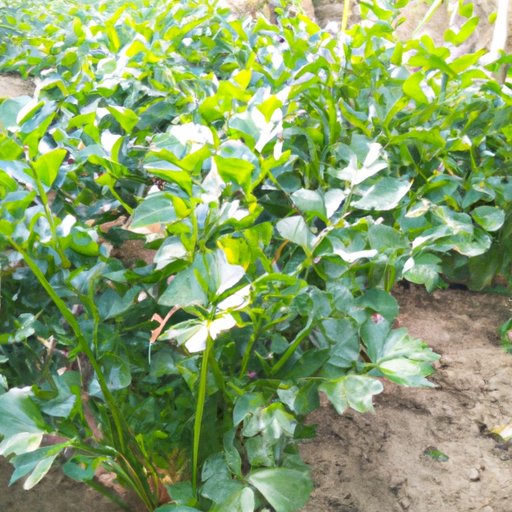
I. Introduction
Celery is a versatile, nutritious, and delicious vegetable that has numerous health benefits. However, growing celery can be a bit challenging, especially for beginners. That’s why we have created this comprehensive guide to help you grow celery successfully. In this article, we will take you through the basics of growing celery, tips for planting in different climates, preparing the soil, fertilization and watering, pest and disease management, harvesting and storing, and innovations in celery farming.
II. Start with the basics: A beginner’s guide to growing celery
Before diving into the specifics, it’s essential to understand how celery grows and what kind of conditions it requires. Celery is a cool-season crop that thrives in temperatures of 60 to 70 degrees Fahrenheit. To get started, you can either plant celery seeds indoors six to eight weeks before your last frost date or purchase seedlings from your local nursery.
When planting, ensure that you choose a spot with well-drained soil, rich in organic matter, and receives full sunlight or partial shade. Plant the seeds or seedlings about ¼ to ½ inch deep in the soil and space them 8 to 10 inches apart.
III. Consider your location: Tips for growing celery in different climates
The climate in your region plays an essential role in the success of your celery crop. Celery grows well in cool, temperate, or warm regions with mild temperatures and consistent moisture. If you live in a cooler region, start planting celery in early spring when soil temperatures reach 55 degrees Fahrenheit. In temperate regions, plant celery in late spring to early summer. In warm regions, you can plant celery in the fall or winter.
To adjust planting times based on your climate, the best way to do it is by tracking soil temperature. Using a soil thermometer, take measurements to identify when the soil has reached the optimal temperature for planting.
IV. Prepare your soil: Step-by-step guide to soil preparation for celery farming
Celery performs best in well-drained soils that have a pH level of 6 to 6.8. Before planting, prepare your soil by removing weeds and debris, adding organic matter, and improving soil fertility. Celery roots grow deep, so loosen the soil to a depth of at least 12 inches to allow for proper oxygenation.
You can also adjust the pH of your soil by adding lime to increase the pH, or sulfur to decrease the pH. Test your soil to determine its pH level before making any adjustments.
V. Watering and fertilization: The best ways to keep your celery healthy and thriving
To keep your celery plants healthy and thriving, you need to water them consistently and fertilize them regularly. Celery requires consistent moisture and needs at least 1 inch of water per week to prevent it from drying out. Water your celery early in the morning or in the evening to avoid evaporation, which may lead to water stress.
Fertilize your celery plant about two weeks after planting, and then once every three weeks, using a balanced fertilizer that contains nitrogen, phosphorus, and potassium. Consider using organic fertilizers like compost, bone meal, and blood meal.
VI. Pest and disease management: How to protect celery crops from common threats
Celery is vulnerable to a variety of pests and diseases, including aphids, slugs, cutworms, and celery mosaic virus. To prevent pests, handpick bugs as often as possible and use organic pesticides to keep pests at bay. To protect your celery plants from diseases, ensure you practice good cultural practices like crop rotation, applying fungicides, and keeping the soil healthy.
VII. Harvesting and storing celery: Tips for getting the most out of your celery crop
Harvest your celery when the stalks are crisp and about 8 inches long. Using a sharp knife, cut the stalks near the base of the plant, being careful not to damage other stalks or leaves.
To store your celery, wrap it in a damp paper towel and place it in a plastic bag in the fridge. If you want to preserve celery for future use, you can blanch the stalks, chop them into small pieces, and freeze them.
VIII. Innovations in celery farming: Exploring new techniques and technologies for growing celery
Farming technology has come a long way, and celery farming has not been left behind. Greenhouse farming, hydroponic farming, and vertical farming are some of the latest innovative practices in modern celery farming. These practices allow for the growth of celery all year round, regardless of the weather conditions.
IX. Conclusion
In conclusion, growing celery can be a fulfilling and rewarding experience. This comprehensive guide outlines the basics of how to grow celery, starting from selecting the right seeds to harvesting and storing your crop. We hope that this article has provided you with the knowledge and skills that you need to produce a healthy, delicious celery crop at home.
So why not start growing your own celery today? It’s good for your health, your taste buds, and your wallet.





